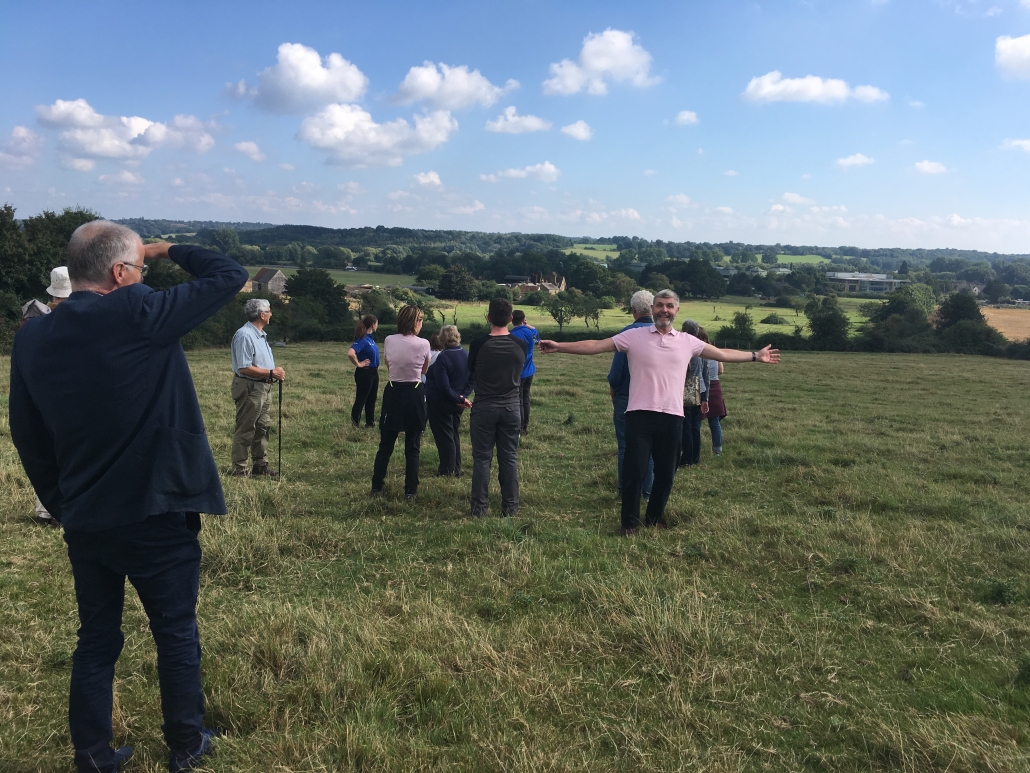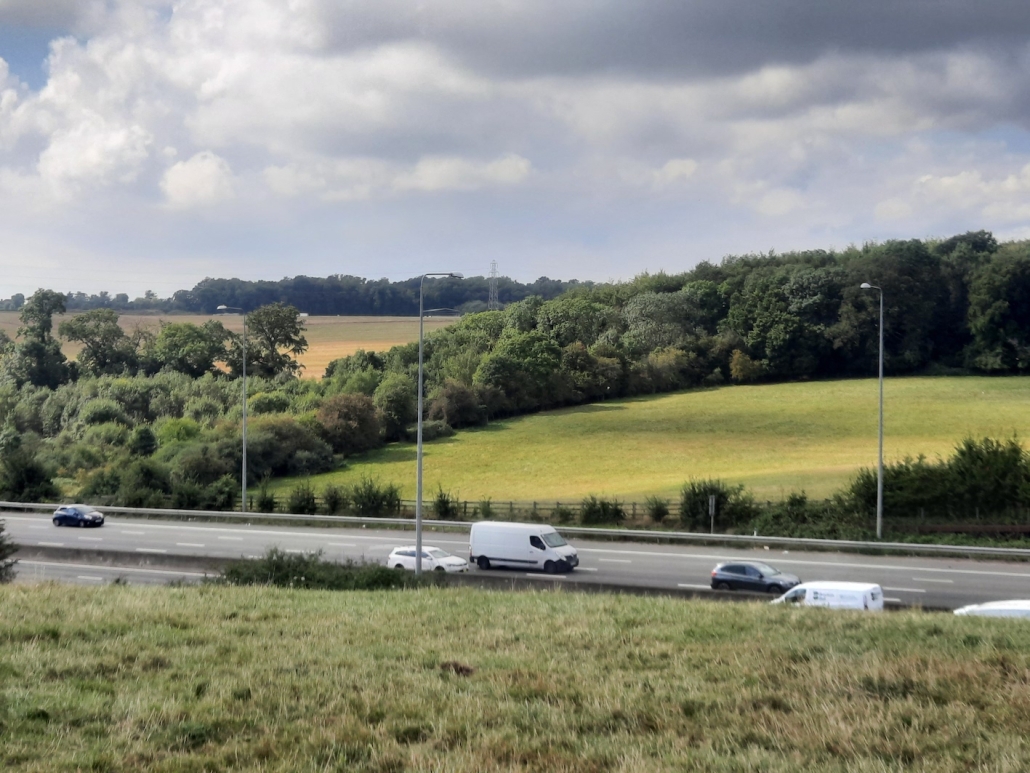Over the last year, our website has featured pieces written by our trustees where they give their individual perspectives on what the Colne Valley Regional Park means to them.
CVRP Chairman John Whitby is a local farmer who has lived and worked in the Colne Valley all his life, playing a leading role in preserving this unique landscape for future generations to enjoy.
By necessity and training, John has been a champion of the importance of farming and farmers as a key fixture of life on the rural-urban fringe. Throughout his career, he has written and spoken widely on this subject, as well as welcoming interested groups( particularly school children) to the farm.
John Whitby welcoming school children to learn about the importance of conservation grazing
John recently came across an article he wrote 23-years-ago and was immediately struck by just how much of it still rings true today. At that time he was serving as County Chairman of the local branch of the National Farmers Union(NFU), and was required to contribute a monthly column to the union’s members’ magazine.
The National Farmers’ Union currently has 55,000 members, flying the flag for the otherwise overlooked and underestimated importance of food production as the underlying imperative for a rich mosaic of land uses. It is this land use that underpins the positive enhancement of the landscape, biodiversity, public access and the health and wellness benefits a thriving countryside brings to everyone.
John’s article on the Green Belt first appeared in 2000 and we reproduce it below exactly as it appeared back then. He notes that while some of the policies mentioned have been superseded, much of the article remains relevant today. The threat of the rail freight terminal he alluded to has receded, only to be replaced with other equally damaging threats.
He observes that 20 years ago there was still an effective and accountable regional planning authority. It was abolished in the Localism bill in 2011 – a principal consequence being the near-fatal disengagement of meaningful spatial planning. This has led to an overheated reliance on Green belt designation, in our case the concentric ring around London, as the much-maligned bedrock policy of rural-urban fringe planning.
John said: “I’m proud to be leading the Colne Valley Regional Park as it redoubles its efforts to see the creation of a fair, equitable and sustainable spatial plan that properly protects this uniquely challenged area. The development threats it faces today are completely unprecedented. I firmly believe that the work we are doing now could become a best practice model for future land use integration in other parts of the country.
“It is always valuable to look back and understand where we have come from and an understanding of the history of the Green Belt informs this,” he added.
The Green Belt, in the absence of other designations, still survives, but it is overdue for reform. John continues to ask that we should not lose sight of the value of agriculture and local food as a key facet of these changes. He argues that this is not some bucolic vision but is vital for the continuing success of our locality. He is both nervous yet optimistic in looking forward to what the next 23 years might bring.
The Green Belt – an example of evolving Planning Policy (Written by John Whitby April 2000)
The Green Belt has been the corner stone of land use planning policy for almost half a century and from its inception has received widespread support from planners and public alike. Today however the Green Belt, like many other designated areas, is under threat not just from development pressure but also because of the demise in the prosperity of agriculture. Liassez faire Government attitudes concerning traditional food producing farming may mean that the Green Belt is soon consigned to the history books: it will then be to late to lament its passing.
My local paper has mounted a laudable campaign to save the countryside (the Green Belt is its hinterland) from the ravages of housing, industrial and transport infrastructual developments. This is set against a background where the South East is a boom area and where house prices, in Gerrards Cross (where my family are still tenants of a small farm) for example, are amongst the highest in the whole of the UK. The paper has elicited comment from Mp’s, councillors, celebrities and other worthy locals but seems to totally miss the key point. The Green belt is a farmed landscape; farming is in severe difficulty and farmers are quite reasonably (although not necessarily because they want to) looking to tap into the perceived rich vein of diversification. Some are using this new income to sponsor traditional farming activity but increasingly many are bestowing farming to the dustbin of hobbyism.
A study of the history of Green belt policy shows that Patrick Abercrombie was its founding father. His Greater London plan of 1944 foresaw a designated green ring around London with housing development needs centred on new towns outside the ring such as Welwyn or Harlow. The Green Belt policy emerged formally in 1955 and was championed by Government Minster Duncan Sandys who, against considerable opposition from urban local authorities and private developers, adamantly oversaw it onto the statute. A recent policy statement on Green Belts (the revised PPG 2 of 1995 ) confirms the validity and permanence of the Green Belts, which now cover over one and a half million hectares (12 per cent) of England. Indeed they have expanded to encompass many of the metropolitan areas of our country.
We all intimately understand the deep depression of farm incomes but in spite of this there is emerging a huge shift in countryside policy. The production of food is just one of a multiplicity of valid uses for land. A plethora of environmental, marketing, diversification and planning initiatives under the guardianship of the rural development agencies are challenging the mindsets of today’s farmer. This will have a profound effect on traditional Green Belt policy. The Countryside Stewardship Scheme for example had as one of its targets Green Belt; providing indirect grant aid for the support of traditional farming activity perhaps linked to improved public access provision.
However there are some trends emerging from the fog that is evolving Government policy. It indicates change. It seems they would have farmers become rural business men, that they want large tracts of green field sites for housing and certainly land for transport, leisure and industry. A huge rail freight distribution terminal with links to the airport and via rail to the Channel Tunnel is muted for South Buckinghamshire. The task for policy makers and farmers alike is to achieve an appropriate balance between the old and the new: for it is the intrinsic ruralness of the Green Belt, together with good communications links, what makes it such a desirable place to live, work and play in.
The real challenge for us is to make sure that both the public and planners understand our plight. Farmers are the key assets in achieving this balance. The $64000 question is whether the local planners up to the task they have been set. For without foresight and innovative thinking they may well stifle the lifeline thrown to a few lucky farmers in the Green Belt.
The Green Belt will never be the same again. The planning revolution is in full swing and as ever is often indiscriminate as to the winners and losers.
Written by John Whitby April 2000






